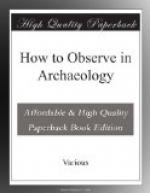A much-cracked glazed jar was packed by winding string round it in all directions, with tufts of wool under the string.
A whole mummy in most fragile condition, so that it could not be lifted, was made up solid with 40 lb. of paraffin wax which was melted out of it afterwards in England, making hardly any change. If contracted burials should be preserved, dust carefully, splash on about 5 lb. of paraffin wax heated to smoking-point. When cold, detach from soil, turn over, paraffin the lower side, and build up weak parts with a sludge of melted paraffin and sand, nearly chilled. About 8 to 10 lb. of wax will do the whole. The skull should be packed separately. Pad all hollows of the body with soft rag to spread pressure in packing. Paraffin wax is the best preservative as it is tough, and may be used as a coat over an object for safety. When not needed it can be cut away, or melted away, and cleaned off completely with benzol. It should be melted in an iron saucepan, as solder will give way if it is superheated. As it melts at about 120 degrees F., and boils at about 600 degrees F., it can be greatly superheated, and used when smoking, so as to penetrate deeply into wood or porous material. It is perfect for strengthening skulls; most rotten examples slopped with paraffin, and finally soused for a few seconds so as entirely to cover the bone in and out, will travel safely, if not crushed.
Boxes must always have corner posts, inside or out; see that the sides are nailed up to the edges to the posts, or the lid or bottom may part by the side splitting. See that all nails—except for the lid—are driven slanting alternately one way and reversed, this prevents sides or bottom drawing off. Nail the lid with many short nails, so that it can be raised without splitting.
To secure heavy objects in a mixed box, an inverted rough stool is the best, the cross piece on the object below, and the sides coming up to the lid. If cross bars are nailed in a box, damage may be done to an object in forcing the bars loose. It is often best to put heavy and light things in the same box, to equalize weights in journeying; if well secured, a mixed boxful travels well. Be very careful that a wedge-shaped stone cannot force itself loose by repeated jolts, or it may split a box.
Slabs of stone ire best packed in open shallow boxes face down on straw or wool, secured by a few diagonal cross bars on the top, as then they do not need to be opened for customs. All stones of regular form should be supported at a fifth of the length from each end. No bedding on a box is worth anything, as the box will bend more than the stone, and the strain will all come on the middle. Very heavy blocks are best with sacking on the face, and roped round in various parts.




